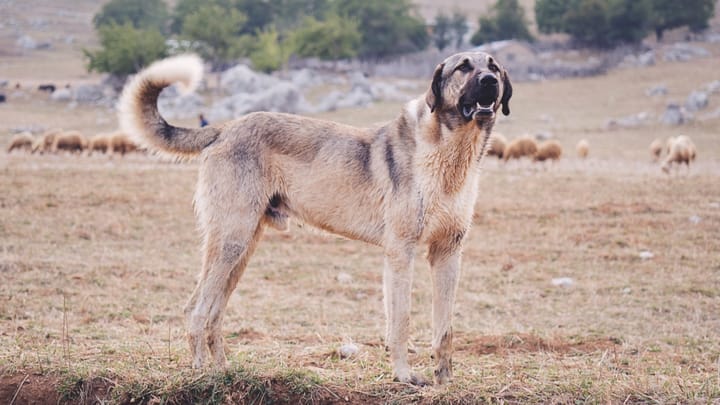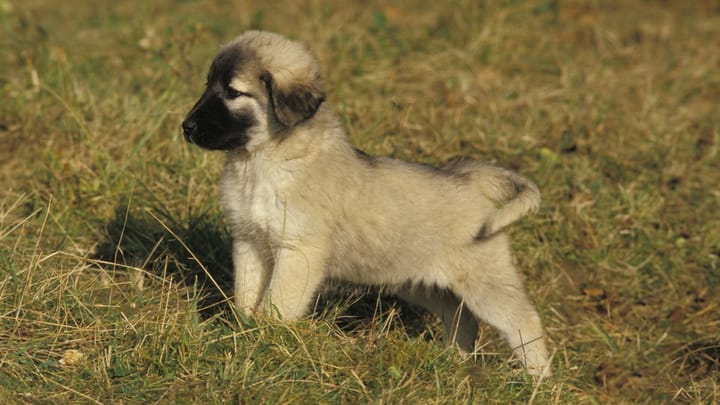Anatolian Shepherd
Other name: Coban Köpegi


The Anatolian Shepherd is a highly intelligent, proud, independent and self-confident dog. They are ancestral guardians who show great interest in the protection of their family and territory. Without ever being unnecessarily aggressive but by showing a certain tenacity when it comes to protecting, these giant-sized dog are very wise, calm and gentle when they are with their family.
|
Life expectancy |
The Anatolian Shepherd has a life expectancy of between 10 and 13 years |
|
Temperament |
|
|
Size |
Large
|
|
Adult size |
Female
Between 28 and 31 in
Male
Between 29 and 32 in
|
|
Adult weight |
Female
Between 99 and 132 lb
Male
Between 121 and 154 lb
|
|
Coat colour
All hair colours are permissible for this Turkish dog breed except for Merle. |
Black White Brown Blue Red Sand |
|
Type of coat
Their coat is short or mid-length. The coat is twofold: a dense topcoat and a thick undercoat. The coat varies in length and density depending on the climate, it is generally longer in winter. |
Short |
|
Eye colour
Their eye colour ranges from golden to brown, depending on the colour of the coat. |
Brown
|
|
Purchase price |
The Anatolian Shepherd costs between £795 and £1310 |
In Namibia, Anatolian Shepherds are used to protect livestock from cheetahs! The Cheetah Conservation Fund breeds Anatolian Shepherds and donates puppies to farmers all over the country. By protecting the farmers' livestock, the dogs limit human-wildlife conflict with the cheetah. Most farmers who own dogs report an 80& to 100% reduction in livestock kills by cheetahs and other predators.
More details about the Anatolian Shepherd
Anatolian Shepherd: Origins and history
The Anatolian Shepherd is an old breed that most likely descends from the great hunting dogs of Mesopotamia. Over time, the breed has evolved to adapt to a series of particular circumstances: those that have most influenced their formation are the climate (very hot summers, very cold winters), the way of life of populations (sedentary, semi-nomadic or nomadic) and the type of work. The FCI officially recognized this Turkish breed in 1989.
Physical characteristics of the Anatolian Shepherd
The Anatolian Shepherd is a strong, large and robustly built dog with a powerful constitution. The head is broad and strong. The eyes are rather small in relation to the size of the skull, well detached and sunken into the orbits. The ears, of medium size, are triangular in shape and rounded at the ends; they fall against the cheeks and are raised when the dog is attentive. The tail is long and reaches the hock. It is set fairly high, carried low at rest and slightly curved; when the dog is attentive it is carried high, with the tip curved onto the back, especially amongst the males.
Anatolian Shepherd: Characteristics
Anatolian Shepherd: Behaviour
Training a Anatolian Shepherd
The Kangal, as this dog may also be known, is considered to be an intelligent and docile dog, even if it is very independent. This temperament often does not coincide with a high level of obedience and yet, for a hound, this dog is particularly receptive.
For their education to be successful, it is necessary to begin training from a young age in order to prevent the Anatolian Shepherd puppy from developing bad habits.
Be careful never to seek any kind of power relationship with this giant dog as they could quickly begin to consider their master as an incoherent and disrespectful being and therefore stop any form of cooperation.
To overcome their occasionally stubborn side, it is necessary to be firm, consistent and self-confident to build a strong relationship. Concessions must be avoided while fostering an education that respects the principles of positive education.
It should be noted that obedience for this dog is a deliberate, unconditioned act. Therefore, commands must be fair and sensible in order to achieve results.
Anatolian Shepherd: Lifestyle
Breed compatibility Anatolian Shepherd
Anatolian Shepherd: Purchase price
The price of an Anatolian Shepherd varies according to their origin, age and gender. It is necessary to count on average £1310 for a dog registered with the KC.
Concerning the monthly budget necessary to provide for the primary needs of a dog of this size, it is necessary to account for approximately £60/month.
Anatolian Shepherd: Shedding
Heavy !
The Coban Köpegi experiences abundant hair loss during the two annual moulting periods, spring and autumn. Brushing should be daily in order to remove as much dead hair as possible. Outside these periods, this dog loses almost no hair.
Anatolian Shepherd: Grooming
The maintenance of this dog is quite simple but requires time given its size. They need regular brushing to maintain the beauty and protective qualities of their coat.
Their drooping ears should be checked and cleaned regularly.
Anatolian Shepherd: Health
Their life expectancy is estimated at 11 years.
This is a very robust dog. The Anatolian Shepherd is made to live in the open air and adapts to almost any situation. They rarely get sick.
Used to the very hot summers of its country of origin, this dog can withstand the heat well, but should not engage in intense physical activity during these periods. It is preferable to go out early in the morning and late in the evening so that they can fulfil their potential and release their energy without suffering from extreme weather conditions.
Equipped with a double coat providing them with good protection, the Anatolian Shepherd is also fortunate enough to have a coat that adapts to different climates.
This dog can easily self-regulate, a healthy and balanced diet combined with regular physical activity prevents them from becoming overweight.
This robust dog knows no specific form of disease. They are not particularly affected by conditions common amongst large dogs, other than hip dysplasia.






